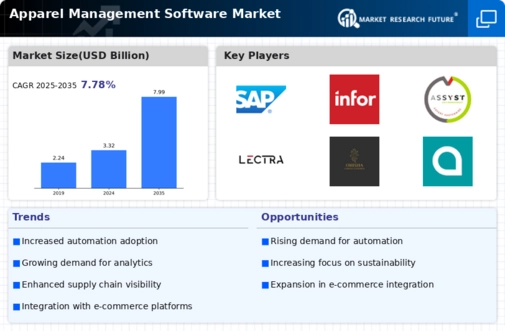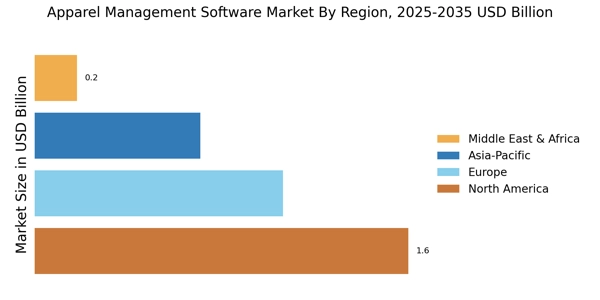Rising Demand for Automation
The Apparel Management Software Market is experiencing a notable surge in demand for automation solutions. As businesses strive to enhance operational efficiency, automation tools are becoming increasingly essential. These solutions streamline processes such as inventory management, order processing, and supply chain coordination. According to recent data, the market for automation in apparel management is projected to grow at a compound annual growth rate of approximately 12% over the next five years. This trend indicates that companies are prioritizing software that minimizes manual intervention, thereby reducing errors and improving productivity. The integration of automated systems not only accelerates workflows but also allows for better data analysis, which is crucial for informed decision-making. Consequently, the rising demand for automation is a significant driver in the Apparel Management Software Market.
Emergence of Mobile Solutions
The Apparel Management Software Market is experiencing a notable shift towards mobile solutions. With the proliferation of smartphones and tablets, apparel businesses are increasingly adopting mobile applications to manage their operations. These mobile solutions provide flexibility and accessibility, allowing users to monitor inventory, process orders, and analyze sales data on-the-go. Recent surveys indicate that nearly 60% of apparel retailers are investing in mobile technology to enhance their operational capabilities. This trend suggests that the demand for mobile-friendly apparel management software is on the rise, as businesses seek to leverage technology to improve efficiency and responsiveness. The emergence of mobile solutions is thus a significant driver in the Apparel Management Software Market.
Expansion of E-commerce Platforms
The Apparel Management Software Market is significantly influenced by the rapid expansion of e-commerce platforms. As online shopping continues to gain traction, apparel businesses are increasingly seeking software solutions that can seamlessly integrate with their e-commerce operations. This integration is vital for managing online inventory, processing orders, and ensuring a smooth customer experience. Recent reports indicate that e-commerce sales in the apparel sector are expected to reach over 500 billion dollars by 2026. This growth presents a substantial opportunity for apparel management software providers to develop solutions tailored to the unique needs of online retailers. Consequently, the expansion of e-commerce platforms serves as a crucial driver for the Apparel Management Software Market, as businesses strive to adapt to changing consumer behaviors.
Increased Focus on Data Analytics
In the Apparel Management Software Market, there is an increasing emphasis on data analytics capabilities. Companies are recognizing the value of data-driven insights to enhance their operational strategies. The ability to analyze sales trends, customer preferences, and inventory levels enables businesses to make informed decisions that can lead to improved profitability. Recent statistics suggest that organizations utilizing advanced analytics tools can achieve up to a 20% increase in sales efficiency. This growing reliance on data analytics is prompting software providers to incorporate sophisticated analytical features into their offerings. As a result, the demand for apparel management software that provides robust data analytics is likely to continue rising, positioning it as a key driver in the market.
Growing Importance of Supply Chain Management
The Apparel Management Software Market is witnessing a heightened focus on supply chain management solutions. As the apparel sector becomes increasingly complex, companies are recognizing the necessity of effective supply chain oversight. Efficient supply chain management is essential for minimizing costs, optimizing inventory levels, and ensuring timely delivery of products. Recent data indicates that companies with robust supply chain management practices can reduce operational costs by up to 15%. This realization is driving demand for apparel management software that offers comprehensive supply chain functionalities. As businesses seek to enhance their supply chain efficiency, the importance of specialized software solutions in the Apparel Management Software Market is likely to grow.


















Leave a Comment